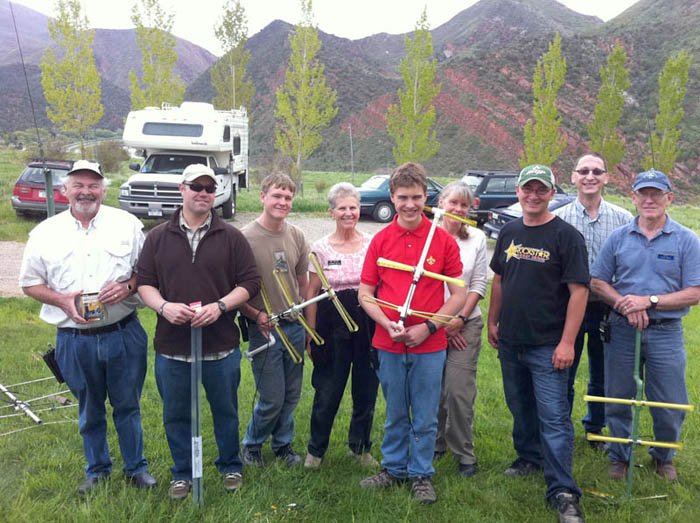
Age and gender don't matter -- everyone can have fun when there are hidden transmitters to be found. The Ski Country Amateur Radio Club in Glenwood Springs, Colorado has been a regular participant in Foxhunting Weekend. (Photo courtesy Bob Cutter KIØG)
Give Foxhunting a Try
by Joe Moell KØOV
Adapted from CQ Magazine, May 2014
When someone says "foxhunting," what comes to mind? Most people envision dozens of mounted horsemen following hounds through an English forest in search of a wily bushy-tailed canine. But to many hams, the fox is a signal to be tracked down with radio direction finding (RDF). Ham radio foxhunting can mean a ride in a vehicle filled with RDF gear to find one or more transmitters that your fellow hams place in unlikely spots to challenge you. Instead of the streets and highways, the hunt site could be a park, with everyone on foot. Better yet is a combination of the two, with a vehicular hunt followed by an on-foot "sniff" at the end to find an off-road fox.
An ideal time for your ham club to try this radiosport is Worldwide Foxhunting Weekend. The vast majority of transmitter hunts take place on the two-meter band with the participants using their handi-talkies and home-made beam antennas. It's simple, inexpensive, and an excellent way to learn soldering and home construction skills.
Most clubs start out with simple mobile foxhunts on a local repeater. They may also call them T-hunts of bunny hunts. Someone goes to an easy-to-find location, such as the parking lot of a local eatery, and makes occasional "come and find me" transmissions on the repeater input. If they're licensed, the hunters can talk back and have a QSO while they hunt. Encourage ride-alongs, so more people can participate.
To make sure that everyone has success, the hider should give hints and clues after a while. When all have arrived, it's time to go inside for dessert and discussion of what equipment and techniques worked, what didn't, and when to have the next hunt. A good time for these practice foxhunts is just after your club's net on the repeater, when listenership is high. Why not start having mini-hunts like this right away, so the group will be ready for something more ambitious during Foxhunting Weekend?
Harder hunts last longer, so hold them on simplex to avoid tying up the repeater. Consider having everyone start at the same point, such as a local hilltop. That avoids giving some hunters the lucky break of being closer to the fox when the hunt starts. It also makes it possible to include odometer readings as a scoring criterion. Instead of the first-to-find team getting the prize, give it to the one with least start-to-finish mileage. Mileage-factor hunts discourage reckless driving, encourage careful plotting of bearings, and they even out the competition. Sometimes the last team to find the fox wins, which keeps the level of excitement high.
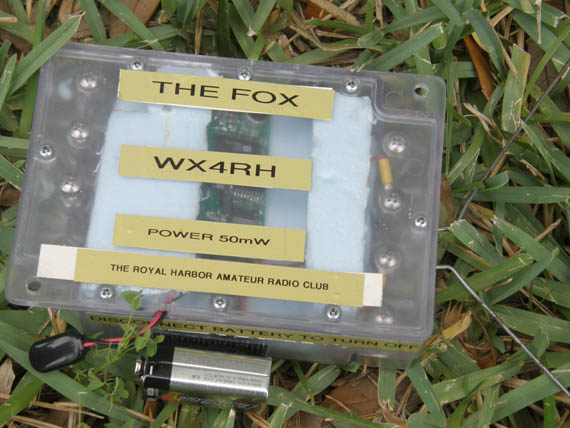
Some clubs have a "foxbox" that is used for every foxhunt, whoever hides it. This 50-milliwatt transmitter awaits members of the Royal Harbor Amateur Radio Club in Tavares, Florida during Foxhunting Weekend. (Photo courtesy Ted Luebbers K1AYZ)
Some prefer to go it alone, but I think that mobile T-hunting is most fun when it is a social activity with several people in the car. The driver concentrates on that task while a passenger gets RDF bearings. That person, or perhaps another passenger, plots the bearings on a map or computer and tries to figure out where the hider is.
USA Versus the World
All-on-foot hunts can be great entertainment, too. What better way to get Scouts and other young people interested in ham radio fun? Scatter a few low-power transmitters in a woodsy park. Encourage everyone to track them down with measuring-tape beams or just with their handi-talkies and scanners. Have everyone bring some food and turn it into a mini-hamfest.
After a couple of romps like this, try on-foot hunting with international rules. In championship foxhunts, staged in a large park or forest, competitors carry a card or an "e-stick" to register at each of the five fox transmitters. Their goal is to find them all and get to the finish line within a set time period, usually about two hours. It goes by several names including foxtailing, radio-orienteering and ARDF. A championship course can encompass more than 1000 acres.
With practice and perseverance, you could win ARDF medals and other honors, no matter what your age. National championships take place annually in about two dozen countries around the world, including USA. Don't be afraid to take on championship courses just because you haven't done much ARDF. It's normal for a high percentage of attendees each year to be newcomers. They are always welcomed and encouraged.
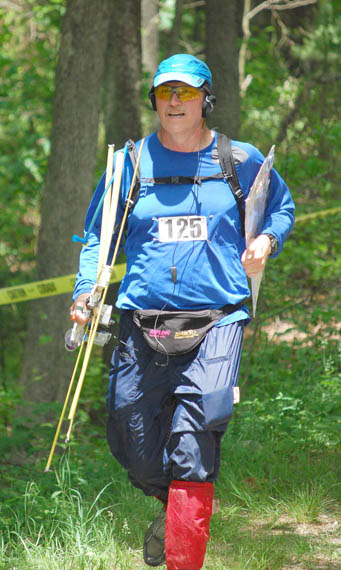
Foxhunting Weekend is a great time to learn on-foot RDF contesting under international rules, called radio-orienteering and ARDF. Jerry Boyd WB8WFK of Albuquerque has been a medal winner at the USA ARDF Championships and serves as ARRL's ARDF Coordinator.
Our national Championships are open to anyone who can run or walk through the forest for five to ten kilometers while carrying RDF gear. A ham license is not a requirement. Expect to meet beginners and experts from all over the world, because foreign competitors usually attend.
Get Ready for the Big Weekend
As Foxhunting Weekend Moderator, I have the pleasure of getting reports and photos from hams who have discovered a new way to enjoy their hobby. What's more, the skills they learn are very important when it's time to find sources of interference, either accidental or intentional. Some of them are now helping Civil Air Patrol and other search/rescue agencies, using RDF to track downed aircraft and persons in distress.
For many clubs, Foxhunting Weekend kicks off a season of regular transmitter hunts. For others, it's a once-a-year event, like Field Day. There are no national/international rules or prizes for Foxhunting Weekend. That's up to you and your fellow hometown hams. You don't even have to schedule it on the scheduled dates. Any weekend in the spring will be fine!
Your hunt can be for mobiles or all on foot. Use the international rules or make up your own. If your club has always had one kind of hunt on Foxhunting Weekend, why not try something different this year?
Some hams prefer formal transmitter hunts with carefully crafted boundaries, specifications for signal parameters, time limits, and so forth. Others are completely content just to have one or more signals to hunt --- no need for any regulations they say. Talk it up on the local repeater and see what your friends have in mind.
Planning hunts and building gear can be almost as much fun as the actual transmitter tracking. Some clubs hold workshops for building measuring-tape yagis and active attenuators before a two-meter foxhunt. This Homing In site has the announcement of this year's Foxhunting Weekend, an article on mobile T-hunting that you can put in your club's newsletter, information about international-rules radio-orienteering and ideas for RDF equipment that will make a foxhunter out of anyone with a two-meter handi-talkie.
Every member of your club is a potential participant in Foxhunting Weekend. Better yet, include the whole community, especially young people. Invite a Scout troop to experience on-foot transmitter tracking or to ride along with the mobile hunters. Look for opportunities to incorporate foxhunting into Scout activities such as Camporees, Scout-O-Ramas and Jamboree-On-The-Air.
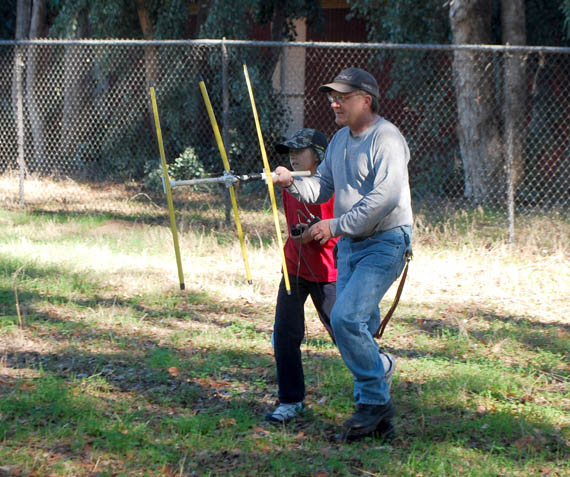
With a yagi made from PVC pipe and an old measuring tape, plus an attenuator, on-foot foxhunting on two meters is easy and fun. Tom King KA6SOX and his son Justin are looking for hidden transmitters at Lake Los Carneros near Santa Barbara, California.
Whatever your club's RDF contesting style, be sure to keep safety in mind. Don't put transmitters where someone might get hurt getting to them. Make sure that all transmitting and receiving antennas are eye-safe. Always be mindful of your own physical limitations and never take chances behind the wheel or in the forest.
Be sure to take lots of photos and submit a complete hunt report for your club newsletter so that everyone will be encouraged to come out for the next hunt. I'd like to get a copy of your hunt report also, or a link to the newsletter that includes the report. I would enjoy learning about the new ideas that you come up with. Happy Hunting!
© 2024 Joseph D. Moell. All rights reserved.
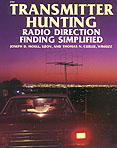
 Go to the Let's Go Mobile T-hunting page
Go to the Let's Go Mobile T-hunting page
Go to the International Style Transmitter Hunting Comes to the Americas page
Go to the Championship ARDF News page
Back to the Worldwide Foxhunting Weekend page
Back to the Homing In home page
This page updated 22 March 2024
,
,
,
,





